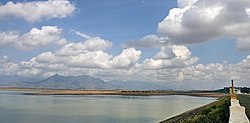Vaigai River
| Vaigai River | |
|---|---|
 | |
 Map of Vaigai river | |
| Location | |
| Country | India |
| Physical characteristics | |
| Source | Varusanadu Hills |
| • location | Tamil Nadu, India |
| Mouth | |
• location | Palk Strait, India |
• elevation | 0 m (0 ft) |
| Length | 258 km (160 mi) |
| Discharge | |
| • average | 36 m3/s (1,300 cu ft/s) |
| Discharge | |
| • location | Peranai[1] |
| • average | 28.8 m3/s (1,020 cu ft/s) |
| hide Vaigai River Course | ||||||||||||||||||||||||||||||||||||||||||||||||||||||||||||||||||||||||||||||||||||||||||||||||||||||||||||||||||||||||||||||||||||||||||||||||||||||||||||||||||||||||||||||||||||||||||
|---|---|---|---|---|---|---|---|---|---|---|---|---|---|---|---|---|---|---|---|---|---|---|---|---|---|---|---|---|---|---|---|---|---|---|---|---|---|---|---|---|---|---|---|---|---|---|---|---|---|---|---|---|---|---|---|---|---|---|---|---|---|---|---|---|---|---|---|---|---|---|---|---|---|---|---|---|---|---|---|---|---|---|---|---|---|---|---|---|---|---|---|---|---|---|---|---|---|---|---|---|---|---|---|---|---|---|---|---|---|---|---|---|---|---|---|---|---|---|---|---|---|---|---|---|---|---|---|---|---|---|---|---|---|---|---|---|---|---|---|---|---|---|---|---|---|---|---|---|---|---|---|---|---|---|---|---|---|---|---|---|---|---|---|---|---|---|---|---|---|---|---|---|---|---|---|---|---|---|---|---|---|---|---|---|---|---|
| ||||||||||||||||||||||||||||||||||||||||||||||||||||||||||||||||||||||||||||||||||||||||||||||||||||||||||||||||||||||||||||||||||||||||||||||||||||||||||||||||||||||||||||||||||||||||||
The Vaigai is a river in the Tamil Nadu state of southern India; it passes through the towns of Theni, Dindigul and Madurai.[2] It originates in Varusanadu Hills, the Periyar Plateau of the Western Ghats range, and flows northeast through the Kambam Valley, which lies between the Palani Hills to the north and the Varushanad Hills to the south. The Vattaparai Falls are located on this river. As it rounds the eastern corner of the Varushanad Hills, the river turns southeast, running through the region of Pandya Nadu. Madurai, the largest city in the Pandya Nadu region and its ancient capital, lies on the Vaigai. The river empties into the Palk Strait near Uchipuli, close to Pamban bridge in Ramanathapuram District.
The Vaigai is 258 kilometres (160 mi) long, with a drainage basin 7,031 square kilometres (2,715 sq mi) large.[3]
Vaigai Mention[]
Sangam literature (circa 300 B.C.[citation needed] has paid many tributes to Vaigai, extolling it as 'the river that brings water when one touches it', viz the etymology Vai (place your) + gai (hands) = place one's hands.[citation needed] The following story is told about the birth of the river Vaigai etc. Meenakshi, the daughter of a Pandyan king, was an incarnation of Parvati. From a very young age, she made up her mind to marry Lord Shiva and none else. Her family was initially against this but eventually consented to her wish and arranged the wedding. Sundareswara (Siva), being an ascetic, came to the wedding without any family or relatives accompanying him. Disappointed at this, the Pandyan king angrily showed Siva the huge amount of food prepared for the bridegroom's relatives. Siva pointed to a friend he had brought with him saying 'He will consume all the food that you've made'. This friend was a Rakshasa named Kundodhara. After Kundodhara finished all the food that was prepared, He became very thirsty and started asking for water. All the wells and canals in Madurai were not sufficient to quench his thirst. Then, Siva asked Kundodhara to put his hand out and opened a small part of his hair lock and Ganga began to flow into his hand. After quenching his thirst, The rest of the waters began flowing in Madurai as the Vaigai river. Vaigai means 'put your hand out' in Tamil.

Tributaries[]
The main tributaries of the river Vaigai are, the river Suruliyaru, the river Mullaiyaaru, the river Varaganadi, the river Manjalaru, river kottagudi and river Kridhumaal, Upparu river. Vaigai Dam is the major dam in this river which is present in Theni District
Vaigai gets major feed from the Periyar Dam in Kumili, Kerala. Water from the Periyar River in Kerala is diverted into the Vaigai River in Tamil Nadu via a tunnel through the Western Ghats. In summers, the Vaigai river ends up dry very often. The water never reaches Madurai, let alone flowing into places past Madurai.[citation needed]
Dams[]

The Vaigai Dam is built across the river in Periyakulam Taluk, in the Theni district of Tamil Nadu. It provides water for irrigation for the Madurai district and the Dindigul district as well as drinking water to Madurai and Andipatti.[4] Near the dam, the Government of Tamil Nadu has constructed an Agricultural Research Station for researching the growing of a variety of crops, including rice, sorghum, blackgram, cowpea and cotton.[5]
The Periyar Dam was built in 1895 by John Pennycuick, who implemented a plan proposed over a century earlier by Pradani Muthirulappa Pillai of Ramnad. The dam was built by the British Army Engineering corps for the Travancore kingdom. The first dam was washed away by floods, and a second masonry dam was constructed in 1895.[citation needed]
"Greater than the mother bearing child/Greater than the child that is born/Every breath is Periyar/Every word is Periyar/In every place, in all the world/As far as Periyar water flows/Your name will stand-Pennycuick-your name/Though written on water, will always stand".[citation needed]
That is how Anthony Muthu Pillai (1863–1929) had paid tributes in Tamil to John Pennycuick, the engineer who had taken up the "audacious and unprecedented feat of...engineering" for transferring some water from the Periyar river in Travancore State to the Vaigai basin in Madras Presidency.[citation needed]
See also[]
References[]
| Wikimedia Commons has media related to Vaigai. |
- ^ "Gauging Station - Data Summary". ORNL. Retrieved 1 October 2013.
- ^ Madurai, Temple Town of South India. Cultural capital of Tamilnadu
- ^ Garg, Santosh Kumar (1999). International and interstate river water disputes. Laxmi Publications. p. 10. ISBN 978-81-7008-068-8. Retrieved 16 May 2011.
- ^ "Water released from Vaigai dam for irrigation". The Hindu. Retrieved 9 August 2007.
- ^ "Welcome to Agricultural Research Station, Vaigai Dam". Tamil Nadu Government. Retrieved 9 August 2007.
- Rivers of Tamil Nadu
- Rivers of India
- Geography of Madurai
